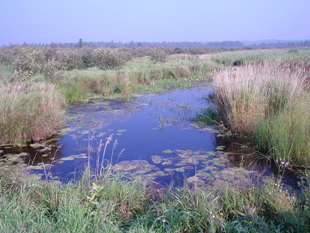The total watershed area is 56 km² or 5,554 ha and the total watercourse length is 54 km.
Layton River
The Layton River, located west of Lake Scugog, flows from north to south until it reaches the Nonquon River southwest of Seagrave.The river's watershed covers an area of 56 square kilometers, with a total watercourse length of 54 kilometers.The landscape is characterized by 36% natural cover, predominantly coniferous forests, including 261 hectares of forest interior and 12 hectares of deep forest interior.
Significant natural features within the watershed include the Nonquon River #7 Wetland, covering 1,191 hectares, and the Layton River Wetland Complex, spanning 358 hectares.These Provincially Significant Wetlands provide essential habitats for a variety of plant and animal species, contributing to the region's biodiversity.
Environmental assessments indicate that the surface water quality of the Layton River is rated as fair, with total phosphorus concentrations averaging 0.045 mg/L, exceeding the provincial objective of 0.03 mg/L for rivers and streams.The health of benthic macroinvertebrate communities, as measured by the Family Biotic Index (FBI), is considered fair. Forest conditions within the watershed are also rated as fair, reflecting the need for conservation efforts to enhance the area's natural environment.
Understanding the characteristics and environmental conditions of the Layton River is essential for effective watershed management and conservation initiatives, ensuring the preservation of its ecological integrity and the health of the broader Nonquon River system.

Watershed characteristics
Learn about the characteristics of the Layton River watershed.
The dominant forest type is coniferous forest including:
- Forest interior: 261 ha
- Forest deep interior: 12 ha
- 36% natural cover
Provincially Significant Wetlands:
- Nonquon River #7 Wetland: 1,191 ha
- Layton River Wetland Complex: 358 ha
Environmental conditions
The following grades show the environmental conditions for the Layton River watershed.
| Indicator | Result | Grade | Status |
|
Total phosphorus |
0.045 mg/L |
C |
Fair |
The surface water quality grade was based on total phosphorous (TP) and/or benthic macroinvertebrates (aquatic insects) family biotic index (FBI). The provincial water quality objective for TP in rivers and streams is 0.03 mg/L and 0.02 mg/L in lakes. These guidelines were set because levels highter than these guildelines provide conditions for nuisance algae and aquatic plant growth. A TP value below 0.03 mg/L (rivers) or 0.02 (lakes) meets the provincial guidelines and is in the B (good) or A (excellent) grade range, while the result for benthic macroinvertebrates must be 5.00 or lower to receive a B (good) or A (very good to excellent) grade.
| Indicator | Area cover | Percent cover | Grade | Status |
|
Forest cover |
15.2 km² |
27.4% |
B |
Good |
|
Forest interior |
2.5 km² |
4.8% |
D |
Poor |
|
Forested riparian cover |
1.4 km² |
43.5% |
B |
Good |
The combined forest conditions grade for Layton River is ranked as fair.
| Indicator | Area cover | Percent cover | Grade | Status |
|
Wetland cover |
8.0 km² |
14.4% |
A |
Excellent |
Contact Us
Kawartha Conservation
277 Kenrei Road
Lindsay, ON K9V 4R1
Tel: 705.328.2271
Fax: 705.328.2286
Subscribe to Receive Updates and Notifications
Stay up to date on flood and low water, news, activities, events, programs and operations by subscribing to updates and the Watershed Watch Newsletter.
